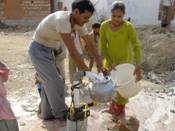|
'Gandhigiri' by Women in Bundelkhand
Pani pe charcha kariyo Teen saal sukha padi hai Moong urd mein bijai kado hai Paani pe charcha... T he song in the local language describes the plight of women in the drought-hit region of Bundelkhand, Madhya Pradesh. Continuous drought for the past three years has left the region deprived of water for drinking, agriculture, livestock and other domestic needs, resulting in deteriorating socio - economic conditions. Water crisis, inevitably leads to poor sanitation, which is directly correlated to poor health, migration, poverty and unequal gender relations.Since the DA-Arghyam ‘Water for All and Always’ project commenced last year in July 2006, a positive change has been observed in about ten villages of Jhansi and Tikamgarh districts in Bundelkhand. The project is designed to provide solutions to the problems in selected ten villages and drawing lessons, leading to a Integrated Water Resources Management Project. The measures taken in the programme include piped water supply and stand posts installation, upgrading the existing hand pumps, water for animals, household toilets, street drainage and field bundling. These interventions have about positive development in the lives of the people; the striking feature here is a major shift in the lives of women who normally remain dormant in many development programmes.
A prominent step taken was to form the Samagra Jal Vikas Samiti (SJVS) or Integrated Water Management Committee in the pilot villages of the project. Though each village has its own SJVSs, what is overwhelming is the 50% representation of women in each these villages. The men of Bagan village openly acknowledge that their women have brought water to the villages. The women of Bagan are enthused with the time saved as a result of installation of tap stands close to their homes. Now they spend as little as 45 minutes to procure water, as compared to the 4 hours earlier. Now they have more time to spend with their children. The Headmaster of the school in village Pipra reports with pride that the drop out rate of girls has reduced significantly. Girls do not have to waste their time fetching water from distant places. There are also signs of improved health conditions. What one can really appreciate is that the communities understand the urgency to conserve water for future. One cannot but see the women of Ganeshgarh apply simple methods of saving water, like using the water that was used to wash vegetables to water the plants or to clean the floor of their house. Water conservation has indeed become a prerequisite for a better habitat. One of the greatest achievements of the project so far has been the mobilization of the village women. The women of Pipra, who preferred confining themselves to the four walls of their houses, bravely came out of the veils and fought with the Sarpanch who engineered damages to the new pipelines as many as six times. But this could not deter the spirit of the women, who were convinced to fight back. They reinstalling the pipes and, finally, there are 17 tap stands in the village now. The women themselves contributed with cash and labour. Regular water supply in the morning from 5-9 and evening from 7-10 has brought about positive habitat improvement. According Mr Srivastav, a resident of the village ‘Humari Auraton ne gandhigiri dikhai’ (Our women followed the Gandhian principles.) Challenges Ahead The women of Hastinapur village of Jhansi district talk with concern about the common social conflict, which is defecating in private fields. They feel the need for toilets at household levels. The DA-Arghyam project follows a demand-driven approach. Having first responded to the basic needs of the people like installation of piped water posts, upgradation of the existing handpumps, construction of water troughs and field bundling, the project is gradually looking at constructing toilets, as they are a key component for complete habitats. All the aspirations are yet to be fulfilled. Today, these confident women are demanding pucca houses, pucca roads, drains, a community hall and services like hospitals and schools. They sure know the way to lead. They have reaped the benefits of Gandhigiri and know what road to take. qAbhishikta Roy |
 The
strength of the project has been its integrated approach. Not only does
it make water available but also addresses issues like capacity building
of the community, sanitation and health. The project recognizes the
varied needs and concerns of different sections of the community hence
it is making efforts to address the concerns of all the groups
separately. The Participatory Rural Appraisal (PRA) exercises and
focused group discussions, which were conducted by DA’s Social Action
Group (SAG), helped to list the concerns of the women folk separately
from other stakeholders like farmers and men. Thus, one can easily trace
the mantra to ensure equity in habitat development.
The
strength of the project has been its integrated approach. Not only does
it make water available but also addresses issues like capacity building
of the community, sanitation and health. The project recognizes the
varied needs and concerns of different sections of the community hence
it is making efforts to address the concerns of all the groups
separately. The Participatory Rural Appraisal (PRA) exercises and
focused group discussions, which were conducted by DA’s Social Action
Group (SAG), helped to list the concerns of the women folk separately
from other stakeholders like farmers and men. Thus, one can easily trace
the mantra to ensure equity in habitat development.